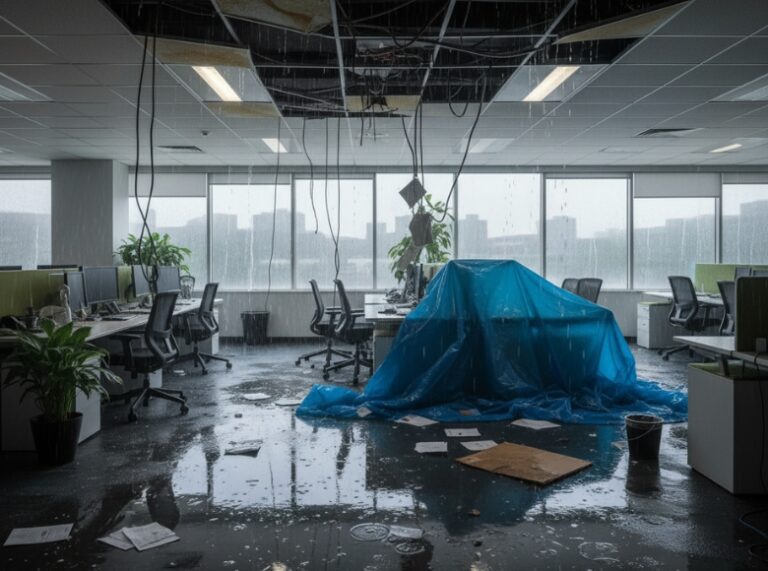Hurricanes and severe storms can unleash catastrophic water damage in minutes, flooding homes and commercial properties and affecting critical infrastructure. Roof may be ripped off causing ceilings to become soaked through by wind-driven rain and foundations can weaken due to persistent flooding. The aftermath often includes hidden structural issues, mold growth, and costly long-term deterioration. Filing a water damage insurance claim after such events requires prompt, detailed action, as incomplete documentation or missed deadlines can delay settlements or reduce payouts. With over 25 years of experience and more than $4 billion recovered for clients, Continental Adjusters structured planning and precise execution consistently maximizes recovery for storm-impacted properties.
How Hurricanes and Storms Cause Water Damage
Storms create a mix of water-related hazards that can complicate claims. Heavy rainfall can overwhelm drainage systems, leading to flooding in basements, parking areas, or low-lying structures. High winds often damage roofs or break windows, allowing rain to penetrate the interior. Meanwhile, burst pipes or sprinkler systems during storms can add internal flooding, sometimes unnoticed for days. These combined effects challenge insurers, who must determine the cause, extent, and financial impact of the damage.
Property owners frequently overlook hidden issues. Mold may grow behind drywall, wooden flooring can warp, and structural beams may weaken all without immediate signs. Early documentation, including high-resolution photographs and professional assessments, is essential. Insurers rely on these records to determine fair compensation, making detailed, organized evidence indispensable.
Why Filing Your Water Damage Insurance Claim Quickly Matters
Prompt action is critical to prevent further damage and strengthen claim credibility. Early assessment by specialists ensures:
- Rapid evaluation of affected areas before structural deterioration worsens
- Accurate inventory of damaged items such as electronics, furniture, or machinery
- Immediate mitigation measures like water extraction, tarping roofs, or temporary repairs
Waiting increases the risk of hidden damage worsening, complicating proof of loss. For example, water trapped behind walls can cause structural rot, making it harder to distinguish between pre-existing conditions and storm-related damage. A swift, documented response preserves property integrity and supports the water damage insurance claim.
Step-by-Step Guide to Filing a Water Damage Insurance Claim
- Document Every Loss Immediately
Take high-quality photos and videos of all damage from multiple angles. Record serial numbers, receipts, and original purchase details. Include both visible and concealed damage, such as mositure behind cabinets or under flooring. Comprehensive documentation reduces disputes and accelerates claim processing. Tools like moisture meters or thermal imaging cameras can help detect hidden water intrusion.
- Separate Damages by Source
Insurers often differentiate between wind, flood, and internal plumbing damage. Categorizing losses clearly clarifies coverage eligibility and avoids deductions based on misinterpreted causes.
- Engage Licensed Professionals
Contractors, engineers, and mold remediation experts provide credible reports and repair estimates. Their technical evaluations validate both structural and personal property losses, offering critical support during claims disputes.
- Track Extra Expenses
Storm recovery may require temporary lodging, equipment rentals, or emergency repairs. Maintain detailed logs and receipts for all additional expenses. Documentation ensures these costs are recoverable under the claim.
- Communicate Effectively With Insurers
Consistent, clear communication reduces delays. Provide detailed inventories, professional assessments, and supporting evidence. Written submissions carry more weight than verbal explanations, especially in complex or large-scale claims.
- Preserve Evidence During Repairs
Even after mitigation begins, keep records of all repair work. Retain photos before and after repairs, invoices, and contractor notes. Maintaining evidence ensures accurate settlement calculations and demonstrates diligence.
Common Mistakes in Water Damage Insurance Claims
- Incomplete Documentation: Skipping photos, receipts, or serial numbers can lower settlements.
- Delaying Claims: Late filings create uncertainty about the origin of damage.
- Overlooking Secondary Damage: Hidden issues, such as water behind walls or under floors, may be underestimated.
- Neglecting Policy Details: Ignoring limits, exclusions, or deductibles can leave some losses uncompensated.
Regulatory and Industry Guidelines
Federal and industry authorities emphasize thorough reporting for disaster-related claims. FEMA recommends detailed documentation of storm damage for federal aid eligibility. The National Association of Insurance Commissioners encourages transparent recordkeeping and adherence to insurance policy requirements. Following these guidelines ensures the claims process is fair, compliant, and expedient.
Benefits of Organized and Documented Claims
- Faster Settlements: Complete documentation reduces insurer requests for additional evidence.
- Accurate Valuation: Detailed records prevent underestimation of damages.
- Reduced Disputes: Clear evidence mitigates risks of partial payments or denials.
- Future Risk Mitigation: Tracking damage highlights areas vulnerable to future storms.
Real-World Case Insights
- School District Water Damage Claim: A burst pipe beneath a basketball court caused structural voids. Initial denial was overturned after technical documentation and policy review, resulting in full replacement funding.
- Commercial Flood Claim: A multi-building office complex suffered storm surge flooding. Comprehensive inventories, contractor estimates, and mitigation records secured a significantly higher settlement than initially offered.
These examples show that structured, early, and thorough documentation consistently improves claim outcomes.
Water Damage Insurance Services by Continental Adjusters
Continental Adjusters specializes in handling complex water damage insurance claims after hurricanes and storms. Services include:
- On-site assessment and professional documentation of structural and personal property losses
- Coordination with licensed engineers, contractors, and remediation specialists to validate damages
- Detailed preparation of inventories, repair estimates, and proof-of-loss submissions
- Strategic negotiation and advocacy to maximize settlements
- Nationwide and international claims handling, ensuring compliance with state and federal regulations
The experienced teams at Continental Adjusters use technical expertise and decades of industry knowledge to identify overlooked damages, uncover hidden losses, and streamline claim processing. Every step ensures claims accurately reflect the true scope of water damage and recovery needs.
Contact Continental Adjusters for Expert Water Damage Insurance Assistance
For properties impacted by hurricanes or storms, expert guidance can make a significant difference. Continental Adjusters provides timely support to optimize insurance recovery through professional documentation, claim management, and advocacy, helping secure fair settlements.
After hurricanes and storms, navigating a Water Damage Insurance claim can feel overwhelming. Continental Adjusters helps property owners recover by managing complex large-loss claims with precision and transparency. The firm’s team works with engineers and restoration experts to document structural and contents damage, ensuring insurers receive complete, accurate proof of loss for faster, fairer settlements. For decades, Continental Adjusters has guided commercial and institutional clients through recovery across more than 40 states. To get expert support for your water damage claim, contact Continental Adjusters.



